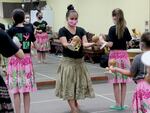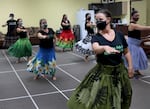Hula instructor Akiko Colton spends her day living and breathing the ancient Hawaiian dance known as hula in her Eugene studio.
“It’s part of my life, so I cannot just take it out. My blood needs hula,” she says.
Colton shares that love of hula as a “kumu” translated as “teacher” in the Native Hawaiian language.
The name of Colton’s dance school is Hālau Hula O Nā Pua O Hawai’i Nei.
“Hālau Hula O Nā Pua O Hawai’i Nei means: ‘hula school of beautiful flowers of Hawaii’” explains Colton. “So we consider each of us a flower from Hawaii and hopefully all learn to be beautiful as we learn how to hula.”
The artform of hula dancing developed in ancient Hawaii. But by 1830, Queen consort Ka’ahumanu, who had converted to Christianity, banned the cultural performance.
Then, in 1886, King David Kalākaua brought hula back, saying that hula was the language of the heart and therefore the heartbeat of the Hawaiian people.
“And now we celebrate his effort to bring hula in April at the Merrie Monarch Festival,” Colton says.
The Merrie Monarch Festival is an annual event where schools, known as “halau,” from all over the world come to Hilo on the Big Island to compete and celebrate the ancient tradition.

Hula teacher Akiko Colton, center, teaches her young students how to use the 'uli'uli, a pair of Hawaiian rattler instruments used in both ʻauana and kahiko hula dances.
Steven Tonthat / OPB
Colton teaches two specific styles of hula: kahiko, and ‘auana. Each has distinct dancing styles and clothing.
“‘Hula kahiko,’ is an ancient hula, we use a pahu drum for the beat and usually the chant is often either written for a king, queen, chief, gods or historic places,” she says. “The costumes aren’t too fancy. We make sure they match the era that they came from.”
“‘Hula ‘auana’ on the other hand is considered modern hula. You hear guitar, piano, ukulele. And the costumes come with a variety of colors and fabrics.”
Colton teaches hula to both adults and children as young as five. The classes range from beginning to advanced performance.
Colton’s main goal as an instructor is to ensure that her students learn hula not just as an artistic dance, but as an important part of Hawaiian culture; a way to pass down legends and stories of ancient Hawaii to future generations.
Colton says that when most people think of hula, they think of swaying hips, floating arms, coconut brassiers and green grass skirts.
She wants her students to step away from those stereotypes and focus on the authentic performance and dance techniques of hula.
“I make sure their elbows are in the right place and I think that’s a really big change from their image of actual hula,” she says. “When we practice, storytelling is really important to make sure the motions go to the right place. It’s easy to change the story with just one hand motion.”
Colton starts beginner students off with hula ‘auana because the steps are much easier to learn.
Once they’re a little further along, she slowly introduces elements from hula kahiko.
“The beginner level is very small, partially because of COVID and partially because hula is not as jumping and twirling like other dance forms,” she says. “So unless the parents have a connection to Hawaii, it’s a little bit hard to get the new dancers or beginner class.”
Some students, like Natara Lopez, do have a connection to Hawaii and specifically chose Hālau Hula O Nā Pua O Hawai’i Nei.
“My connection to Hawaii is that I was born and raised there. My husband’s Hawaiian line goes way way back. So just keeping that aspect in the family and them knowing their culture, they have a piece of it at least,” says Lopez.
Oregon is home to a growing number of former Hawaii residents. According to data from the Oregon Employment Department, more than 3,500 people moved from Hawaii to Oregon between 2014 and 2018. Data from the 2020 census also reflects that just under 1% of Oregon’s total population identifies as “Native Hawaiian and other Pacific Islander alone or in combination.”
For Lopez and Colton, Hālau Hula O Nā Pua O Hawai’i Nei offers a space to feel a little closer to home, even though the Hawaiian islands are thousands of miles away.

Students in the adult class at the hula school Hālau Hula O Nā Pua O Hawai'i Nei practice for an upcoming performance.
Steven Tonthat / OPB
Colton’s love of hula started when she first moved to Hawaii from Japan in the late 1990s. While studying at the Bringham Young University - Hawaii, she worked at the Polynesian Cultural Center where she learned about the artistry and history of hula and Native Hawaiian culture.
“I fell in love with music and emotions and all the hand motions and as I study more and I like stories actually behind the songs and all the hard work we have to put to create something good together with the hula sisters and ohana.”
She formally trained with renowned hula instructor Pekelo Day on Oahu, and in 2007 and 2008 competed in the annual Merrie Monarch Festival.
Colton moved to Eugene in 2007 with her family and wanted to find a community of hula dancers to be a part of. Luckily, Day opened up a school in her new town, Na Pua o Hawaii Nei. Colton immediately joined.
She didn’t plan on taking over as the school’s main teacher, but Day surprised her with an offer she couldn’t refuse.
“He just pulled me to the side and said ‘Do you want this halau?’ I was like, ‘What do you mean?’ So he said, ‘Well we decided to move back to Hawaii. So if you like to take over this, halau, this is your halau.’”
Now, as kumu, she continues sharing the long, beautiful and often challenging history of the hula artform.
“Hula tells the stories and of course music and chants with those two together. We can keep Hawaiian culture history alive. Hula carries the legend and history. All the things that our ancestors passed down to us and we need to pass down to the next generation,” reflects Colton.

Hula teacher Akiko Colton, left, teaches her young students in the intermediate class at the hula school Hālau Hula O Nā Pua O Hawai'i Nei.
Steven Tonthat / OPB


